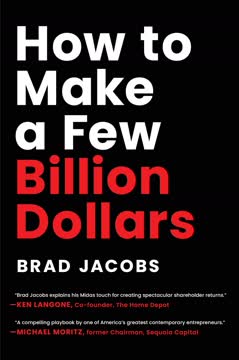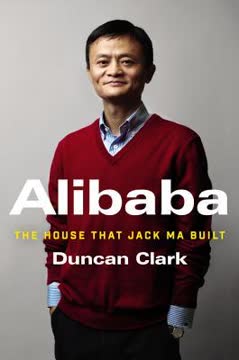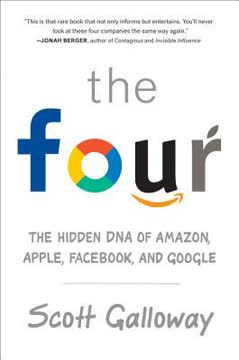Key Takeaways
1. Good profit is created by benefiting customers and society
Good profit comes from making a contribution in society—not from corporate welfare or other ways of taking advantage of people.
Ethical value creation. Good profit is generated when a company creates superior value for customers while consuming fewer resources and always acting lawfully and with integrity. This approach contrasts sharply with bad profit, which stems from corporate welfare, political favors, or exploiting others.
Mutual benefit. Companies that focus on good profit align their interests with those of their customers, employees, and society at large. This alignment leads to sustainable growth and long-term success. By solving real problems and satisfying genuine needs, businesses can thrive while making meaningful contributions to society.
Resource efficiency. Good profit involves not just creating value, but doing so efficiently. This means innovating to produce more with less, reducing waste, and finding creative ways to meet customer needs. Such efficiency benefits both the company and society by conserving resources for other productive uses.
2. Market-Based Management (MBM) drives innovation and value creation
MBM is extremely powerful, but successfully applying it is neither simple nor easy.
Holistic framework. MBM is a comprehensive management philosophy that applies the principles of free markets within an organization. It consists of five dimensions: Vision, Virtue and Talents, Knowledge Processes, Decision Rights, and Incentives. These dimensions work together to create a culture of innovation and value creation.
Continuous improvement. MBM encourages constant experimentation and adaptation. It rejects complacency and pushes organizations to continually seek better ways of doing things. This approach helps companies stay ahead of competitors and drive creative destruction from within.
Employee empowerment. By giving employees the tools and freedom to make decisions based on market principles, MBM taps into the collective intelligence and creativity of the entire organization. This empowerment leads to faster innovation and more efficient problem-solving.
3. Vision guides long-term success and adaptation to change
To achieve our goal of doubling earnings, on average, every six years necessitates continued improvement of our return on capital and an increased ability to generate and capture sufficiently profitable investment opportunities.
Clear direction. A well-defined vision provides a north star for the entire organization, guiding decision-making at all levels. It helps align efforts and resources towards common goals, ensuring everyone is working towards the same objectives.
Adaptability. An effective vision is not static but evolves as the business environment changes. It must be flexible enough to accommodate new opportunities and challenges while maintaining core principles. This adaptability is crucial for long-term survival and growth.
Capability focus. A strong vision is built on a deep understanding of the company's core capabilities and how they can be leveraged to create value. It guides the development of new capabilities and the pursuit of opportunities that align with the company's strengths.
4. Virtues and talents are essential for sustainable growth
Koch transposes that approach. We focus first on values. It is our goal to fill every position with individuals who are equally virtuous and talented, but if forced to choose between one or the other, Koch will chose virtue every time.
Values-based hiring. Prioritizing virtues in hiring ensures a strong cultural foundation. This approach leads to better long-term outcomes, as employees with the right values are more likely to make ethical decisions and contribute positively to the company culture.
Skill development. While virtues are prioritized, talents are still crucial. The key is to hire for values and then develop the necessary skills. This approach allows for a more adaptable workforce that can grow with the company.
Cultural alignment. By emphasizing virtues, companies create a shared set of values that guide behavior across the organization. This alignment leads to more cohesive teams and reduces conflicts that can arise from mismatched values.
5. Knowledge processes fuel continuous improvement and discovery
Knowledge is information that is profitably used to improve results. Just gathering and sharing information that doesn't get results is unprofitable.
Actionable insights. Effective knowledge processes transform raw data into actionable insights. This involves not just collecting information, but analyzing it, sharing it across the organization, and using it to drive decision-making and innovation.
Collaborative learning. Knowledge processes should facilitate the exchange of ideas and best practices across the organization. This collaborative approach leads to faster learning and more rapid improvement.
Measurement and feedback. Key to effective knowledge processes is the ability to measure results and provide feedback. This creates a cycle of continuous improvement, where actions are constantly evaluated and refined based on their outcomes.
6. Decision rights optimize resource allocation and accountability
Decisions should not be made by those in closest proximity, but rather by those with the comparative advantage to make sound decisions, including the best knowledge.
Comparative advantage. Decision rights should be assigned based on who has the best capability to make a particular decision, not necessarily based on hierarchy or proximity to the issue. This ensures that decisions are made by those best equipped to make them.
Clear accountability. Well-defined decision rights create clear lines of accountability. When individuals know they are responsible for certain decisions, they are more likely to take ownership and make thoughtful choices.
Flexibility and adaptation. Decision rights should be flexible and adaptable as circumstances change. As individuals develop new skills or as the business environment evolves, decision rights may need to be reassigned to ensure optimal decision-making.
7. Incentives align employee and company interests for mutual benefit
To achieve good profit, companies should pay people in a way that motivates them to create maximum long-term value, while faithfully following our Guiding Principles.
Long-term focus. Effective incentive systems reward actions that create long-term value, not just short-term gains. This aligns employee behavior with the company's long-term success.
Individual contribution. Incentives should be based on individual contributions to value creation, not just role or seniority. This encourages entrepreneurial behavior and innovation at all levels of the organization.
Holistic evaluation. Incentives should consider not just financial metrics, but also contributions to company culture, knowledge sharing, and other intangible factors that drive long-term success.
8. Creative destruction is necessary for long-term survival and growth
To achieve good profit, companies should pay people in a way that motivates them to create maximum long-term value, while faithfully following our Guiding Principles.
Embrace change. Companies must be willing to cannibalize their own products and processes to stay ahead of competitors. This requires overcoming the natural tendency to protect existing business models.
Continuous innovation. Creative destruction involves constantly seeking new and better ways of doing things. This mindset should permeate all levels of the organization, encouraging everyone to look for opportunities to improve.
Managed risk-taking. While creative destruction involves risk, it should be managed risk. Companies need to balance the need for innovation with prudent risk management to ensure long-term sustainability.
9. Principled entrepreneurship maximizes value for all stakeholders
Principled Entrepreneurship™—creating superior value for our customers while consuming fewer resources and always acting lawfully and with integrity.
Ethical value creation. Principled entrepreneurship involves creating value in a way that benefits all stakeholders - customers, employees, shareholders, and society at large. This approach leads to sustainable, long-term success.
Resource efficiency. A key aspect of principled entrepreneurship is finding ways to create more value while using fewer resources. This not only increases profitability but also benefits society by conserving resources.
Integrity and compliance. Principled entrepreneurs always act lawfully and with integrity. This commitment to ethical behavior builds trust with stakeholders and ensures long-term sustainability.
10. Experimental discovery leads to breakthrough innovations
We have learned that sustained, successful product development requires not only high-quality R&D, but a marketing and manufacturing organization that sees opportunities and has the capability, discipline, focus, resources, and culture to capture them.
Systematic experimentation. Breakthrough innovations often come from systematic experimentation. This involves setting up controlled experiments to test hypotheses and learn from both successes and failures.
Cross-functional collaboration. Successful innovation requires collaboration across different functions - R&D, marketing, manufacturing, etc. Each brings unique perspectives and capabilities that contribute to the innovation process.
Learning from failure. Not all experiments will succeed, but even failures provide valuable learning opportunities. A culture that embraces failure as a learning opportunity is more likely to achieve breakthrough innovations.
Last updated:
FAQ
What's Good Profit about?
- Value Creation Focus: Good Profit by Charles G. Koch emphasizes creating superior value for customers as the foundation of successful business practices. Profit should be a byproduct of serving customers well.
- Principled Entrepreneurship: The book introduces "Principled Entrepreneurship," which involves earning profit through ethical means and mutual benefit, helping others improve their lives.
- Market-Based Management (MBM): Koch outlines MBM, a framework integrating five dimensions to foster innovation and accountability, driving long-term business success.
Why should I read Good Profit?
- Practical Insights: The book offers actionable insights into creating a successful business model based on ethical practices and value creation, applicable to various organizations.
- Understanding MBM: It provides a comprehensive overview of Market-Based Management, a unique framework that encourages innovation and efficiency in competitive environments.
- Inspiration from Success: Koch shares his journey and the evolution of Koch Industries, offering inspiration for entrepreneurs and business leaders through principled entrepreneurship.
What are the key takeaways of Good Profit?
- Principled Entrepreneurship: Focus on maximizing long-term profitability by creating superior value for customers while consuming fewer resources.
- Five Dimensions of MBM: Vision, Virtue and Talents, Knowledge Processes, Decision Rights, and Incentives are crucial for fostering innovation and accountability.
- Creative Destruction: Emphasizes the necessity of continuous innovation and adaptation to remain competitive in changing markets.
What is Market-Based Management (MBM) in Good Profit?
- Unique Framework: MBM is Koch's proprietary management philosophy focusing on creating value for customers and society, encouraging principled entrepreneurship.
- Five Dimensions: Vision, Virtue and Talents, Knowledge Processes, Decision Rights, and Incentives work together to create a cohesive management approach.
- Long-term Growth Focus: Emphasizes long-term thinking and innovation over short-term profits, instrumental in Koch Industries' sustained success.
How does Good Profit define "good profit"?
- Value Creation Focus: Good profit is derived from creating superior value for customers while acting lawfully and with integrity, contrasting with "bad profit."
- Sustainability: Emphasizes that good profit is sustainable and contributes positively to society, reflecting a business's ability to innovate and adapt.
- Mutual Benefit: Rooted in mutual advantage, where both the business and its customers benefit, fostering loyalty and long-term success.
What are the five dimensions of Market-Based Management (MBM) in Good Profit?
- Vision: Creating a clear and compelling vision that aligns the company's goals with customer and societal needs.
- Virtue and Talents: Prioritizing hiring based on values and character, recognizing virtuous employees' contributions to positive culture and success.
- Knowledge Processes: Encouraging continuous knowledge acquisition and sharing to drive innovation and learning from successes and failures.
- Decision Rights: Empowering employees to make decisions within their expertise, promoting accountability and ownership.
- Incentives: Aligning employee incentives with company goals, rewarding long-term contributions over short-term gains.
How does Good Profit address the concept of creative destruction?
- Innovation Necessity: Creative destruction is essential for businesses to innovate and adapt to changing market conditions, remaining competitive.
- Historical Context: References Joseph Schumpeter's idea that capitalism thrives on creative destruction, driving economic growth and consumer welfare.
- Practical Application: Koch Industries' success in navigating creative destruction by evolving its business model and investing in new technologies.
What lessons does Good Profit offer about leadership?
- Values Emphasis: Leading with integrity and aligning organizational values with its vision, modeling expected behavior for employees.
- Innovation Encouragement: Fostering a culture of innovation by empowering employees to take risks and experiment, driving growth.
- Accountability and Responsibility: Creating an environment where employees feel accountable for their actions, making tough decisions, and ensuring compliance with guiding principles.
How can I apply the principles from Good Profit to my own business?
- Value-Centric Approach: Focus on creating superior value for customers while maintaining ethical practices to differentiate your business.
- Implement MBM: Adopt the five dimensions of MBM to create a cohesive management framework, aligning team efforts and driving innovation.
- Continuous Learning: Encourage a culture of knowledge sharing and continuous improvement to adapt to changes and seize growth opportunities.
What role does humility play in Good Profit?
- Leadership Trait: Humility is critical for leaders, allowing them to recognize limitations and others' contributions, fostering collaboration.
- Learning and Growth: Promotes a culture of continuous learning and improvement, where employees feel safe to share ideas and challenge norms.
- Accountability and Integrity: Encourages admitting mistakes and seeking feedback, leading to a more honest and effective workplace culture.
How does Good Profit address the concept of decision rights?
- Employee Empowerment: Align decision rights with individuals' comparative advantages, empowering knowledgeable employees and enhancing accountability.
- Avoiding Bureaucracy: Advocates for a decentralized approach, encouraging initiative and innovation at all levels, rather than rigid hierarchy.
- Role Clarity: Stresses the importance of defining decision rights to ensure employees understand their authority and accountability.
What are the knowledge processes discussed in Good Profit?
- Knowledge Sharing: Emphasizes creating a culture where knowledge is freely shared, leading to innovation and improved problem-solving.
- Continuous Learning: Organizations should continually seek and implement new knowledge to adapt to changing market conditions and customer needs.
- External Networks: Building external networks to gain insights and knowledge from outside the organization, staying competitive and informed.
Review Summary
Good Profit receives mixed reviews, with ratings ranging from 1 to 5 stars. Positive reviews praise Koch's business philosophy and Market Based Management approach, finding it insightful and applicable. Critics argue the book lacks specificity and practical advice, relying on generalities and platitudes. Some readers appreciate Koch's emphasis on value creation and ethical business practices, while others find his political views controversial. The book's content on Koch Industries' history and management principles generates both interest and skepticism among readers.
Similar Books










Download PDF
Download EPUB
.epub digital book format is ideal for reading ebooks on phones, tablets, and e-readers.




